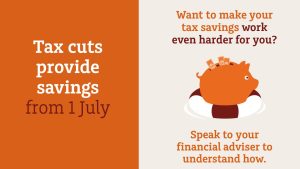Q: What is JobKeeper?
The JobKeeker payment is a $1,500 (gross) fortnightly payment per eligible employee of a business.
The amount will be paid to the employer and is designed to assist employers to continue paying their employees. Eligible employers will receive payments from the beginning of May and payments will be backdated to 30 March 2020. The payments will be available for a maximum of six months.
Q: What if the employee’s income was or is ordinarily less than $1,500 per fortnight?
The full amount of JobKeeper must be paid to eligible employees. This means that if an employee’s ordinary gross fortnightly earnings are less than this amount, this employee will start to receive
increased fortnightly payments from their employer. For example, if an employee usually earns $1,000 per fortnight and the employer receives the JobKeeper payment, then the employee receives their usual salary of $1,000 plus an additional $500.
Alternatively, where ordinary gross fortnightly income was more than $1,500, the employer could choose to provide a top up on top of the JobKeeper payment, so that the employee continues to receive the same wage. This is optional.
Q: Who is an eligible employer?
All business types are eligible, including sole traders, companies, trusts and partnerships (provided that they are not in bankruptcy).
An employer is eligible if the business has turnover of:
- less than $1 billion which has reduced by more than 30% compared to a comparable period a year ago (of at least a month), or
- more than $1 billion which has reduced by more than 50% compared to a comparable period a year ago (of at least a month).
However, the business cannot be subject to the major bank levy.
Charities registered with the Australian Charities and Not-For-Profit Commission are eligible where turnover is estimated to have fallen or is likely to fall by 15% or more.
Turnover is calculated in line with the GST rules (with some modifications for businesses that a part of a GST group). Australian GST law doesn’t apply to overseas sales, and therefore any reduction in foreign operations will not be considered when determining whether or not the turnover test is met.
Q: Can the turnover test be met where a business wasn’t in operation a year ago, or has ‘lumpy’ income?
If business income at a comparable time a year ago isn’t representative of current turnover, discretion may be applied by the ATO to determine eligibility. Additional information and evidence will need to be provided for consideration, to help the ATO determine whether the business has been adversely impacted by the coronavirus pandemic. This may include circumstances where the business is newly established, or where turnover during the comparable period last year was unusually high.
Q: What if turnover hasn’t yet dropped by 30%, but does so during the coming months?
A business may be eligible to start receiving JobKeeper payments at a later time once they see a 30% reduction in turnover. In this case JobKeeper payments will not be backdated to the commencement of the scheme, but is payable from date of eligibility until 27 September 2020.
Q: Who is an eligible employee?
The payment is available for each employee who was on the books as at 1 March 2020 and who is retained, or continues to be engaged. This includes those who have been stood down or let go if the person is subsequently rehired (even if they are immediately stood down again after JobKeeper commences), as long as they were also on the books, and a resident for Australian tax purposes,
on 1 March.
Other eligibility criteria: | Eligible if: |
Age | At least 16 |
Residency status | · An Australian citizen · Holder of permanent visa · Holder of a Protected Special Category Visa Holder · A non-protected Special Category Visa Holder who has been residing continuously in Australia for 10 years or more, or · A Subclass 444 Visa Holder (the Government has indicated other groups |
Employment terms | Available to full-time and part-time workers, as well as casuals who had been employed on a regular and systematic basis with the same employer for at least 12 months. A person may be an eligible casual worker in cases where the business ownership has changed within the last 12 months, provided they have worked in the business for at least the 12 month period. |
More than one employer | Not in receipt of JobKeeper from another employer. Must only receive JobKeeper from the primary employer. The ATO will provide guidance on how to determine who is the primary employer. |
Interaction with Parental Leave Pay | Not eligible if receiving Parental Leave Pay from Services Australia, but will be eligible if on parental leave from employer. |
Workers compensation | Eligible if receiving workers compensation and working (eg reduced hours). Not eligible if not working and the only payment received are those under a workcover insurance policy. |
Q: How does an eligible employer apply?
Eligible employers can register their interest in applying for the JobKeeper payment via the ATO website from 30 March 2020. Check back on the ATO website for the opening of formal applications.
Employers with employees will be able to apply online and must identify all eligible employees. On a monthly basis, updates will need to be provided to the ATO but the details of these updates is not yet known. The employer will receive the payment and be responsible for ensuring eligible employees receive the JobKeeper payment of $1,500 per fortnight (before tax).
Q: What does a business without employees (eg sole trader) need to do?
Employers without employees will need to provide the business’ ABN, provide a declaration on recent business activity, nominate who will receive the payment and that person’s tax file number. Payments will be directed to that person’s bank account. On a monthly basis, the employer will need to make a statement to the ATO that they are still eligible to receive the payment.
Q: What else does a business have to do to continue to receive payments?
Payments need to be reported to the ATO using Single Touch Payroll. Where this system is not used, a manual claim process will apply. Employers receiving JobKeeper are also required to tell all employees that they have been nominated as eligible employees and must pass on all of the payments received. Payments will be made by the ATO monthly in arrears. If an employee on behalf on whom JobKeeper is received resigns or employment is terminated, the ATO but be immediately notified.
Q: Is super guarantee payable on JobKeeper payments?
Super guarantee is not payable on amounts of JobKeeper received by the employee that exceed their usual fortnightly wage or salary. This means if an employee is now receiving more than their usual salary because of the JobKeeper payment, an employer only has to pay SG on the employee’s usual salary amount. Any additional super contributions by the employer would be voluntary. On the other hand, where the employee’s usual salary is only partially subsidised by the JobKeeper payment because their ordinary earnings exceed the JobKeeper amount, the employer is liable to pay superannuation guarantee on the full amount paid to the person.
It is not yet understood how this will be determined for eligible casual workers whose fortnightly hours were subject to fluctuation.
Q: How is the payment treated for social security and tax purposes?
JobKeeper payment is treated as income for social security purposes and may impact eligibility for income support. The payment is taxable income of the employee, and withholding obligations apply.
Q: Can an employee be receiving both JobKeeper and the JobSeeker Payment from Centrelink?
Because the JobKeeper payment is assessable for social security purposes, individuals who receive a social security payment or benefit and start to receive JobKeeper will need to report any change in their income to Services Australia (formally Department of Human Services) within 14 days.
The current income test cut off point for JobSeeker payment is $1,086.50 pf for a single person with no dependants. This means that a single person receiving JobKeeper is effectively ineligible for JobSeeker payment due to the income test.
For more information on the income test cut off points for JobSeeker, see the Services Australia website.
Next steps
To find out more about these are any other issues or concerns you may have, we recommend you contact your financial adviser.
Important information
This document has been prepared by GWM Adviser Services Limited (ABN 96 002 071 749, AFSL 230692) (GWMAS), part
of the National Australia Bank group of companies. Any advice provided is of a general nature only. It does not take into account your objectives, financial situation or needs. Please seek personal advice before making a decision about a financial product. Information in this document is current as at 9 April 2020. While care has been taken in its preparation, no liability is accepted by GWMAS or its related entities, agents or employees for any loss arising from reliance on this document. Any opinions expressed constitute our views as at 9 April 2020. Case studies are for illustration purposes only. Any tax information provided is a guide only. It is not a substitute for specialised tax advice.
GWM Adviser Services Limited (ABN 96 002 071 749, AFSL 230692) (‘GWMAS’). A member of the National Australia Bank Limited (‘NAB’) group of companies. NAB does not guarantee or otherwise accept any liability in respect of GWMAS or these services.






